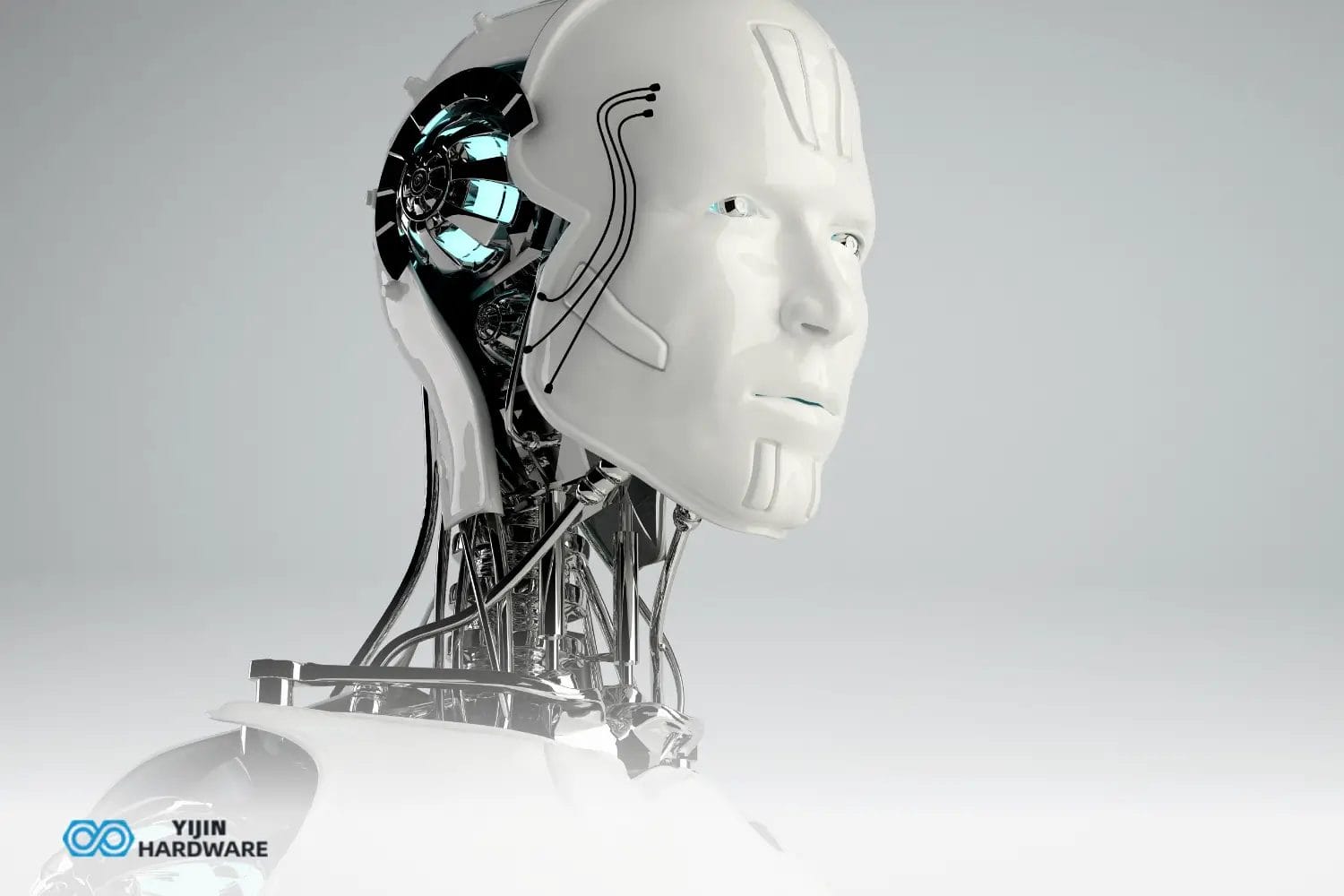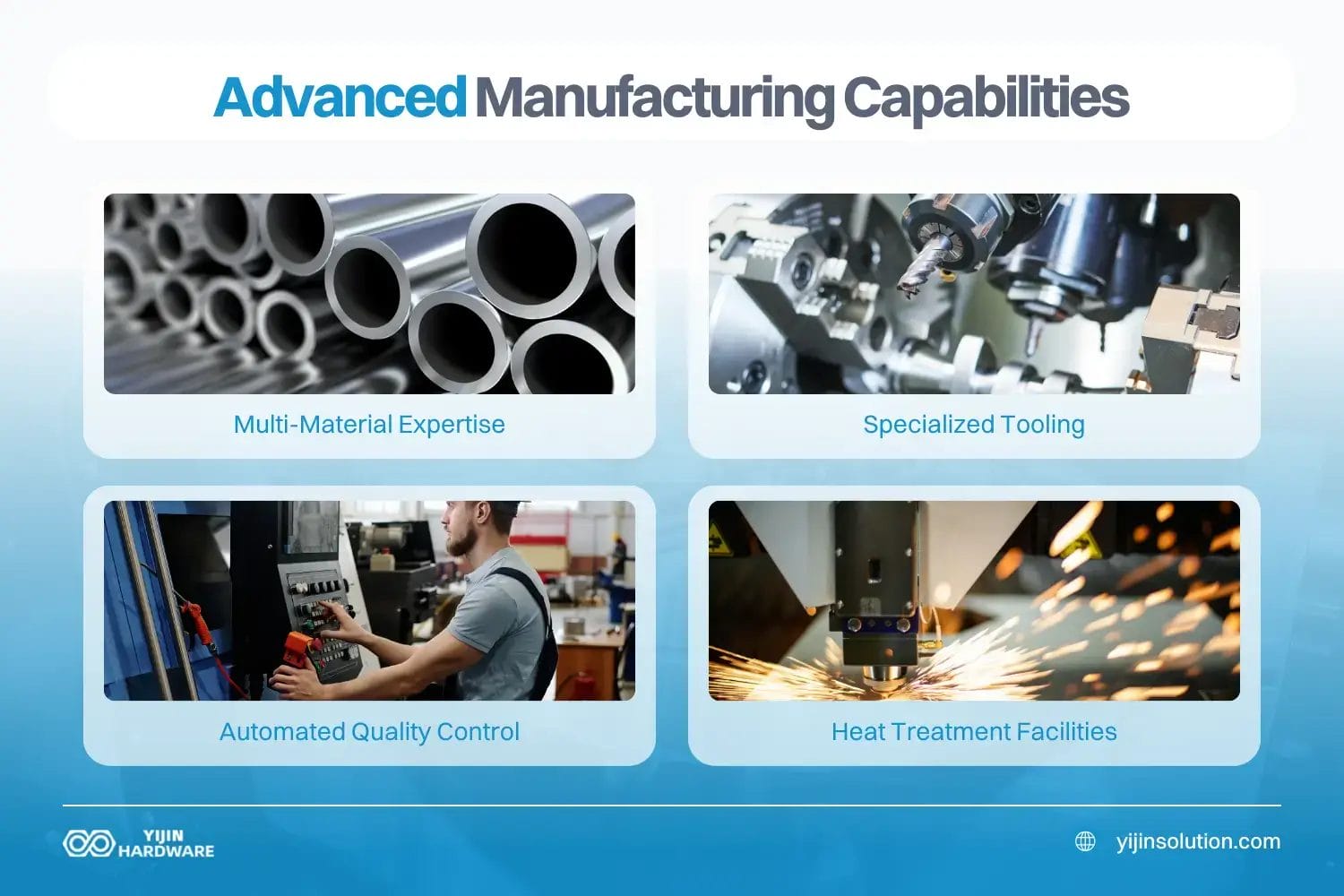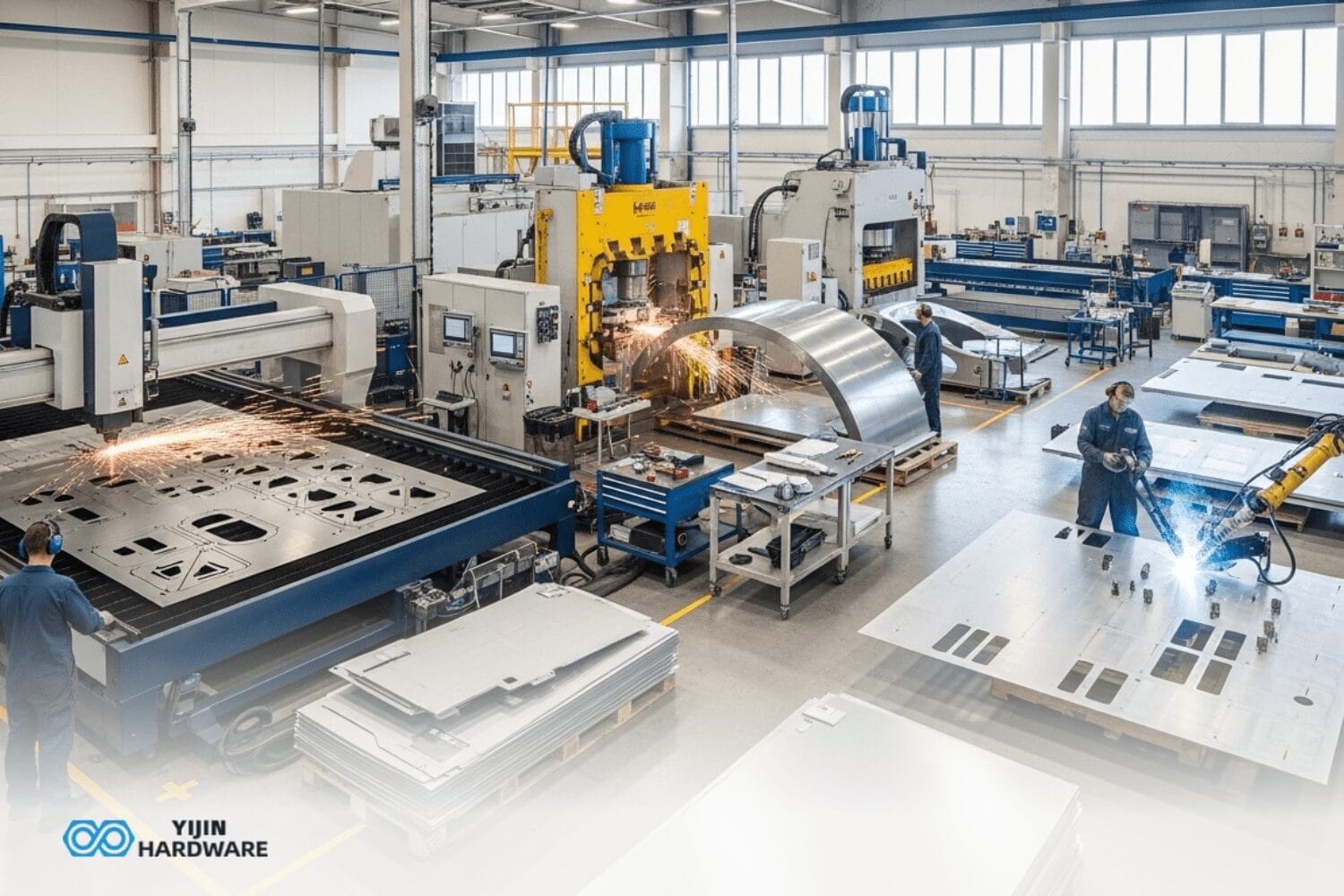The humanoid robot factory game has completely changed from very basic prototype workshops to intense manufacturing facilities. These spaces, like ours, have mass production capabilties. Yijin Hardware blends precision CNC machining, advanced assembly methods, and AI model integration.
Key Takeaways
- Yijin Hardware leads in precision CNC component manufacturing for humanoid robots with tolerances of ±0.005 mm
- Global humanoid shipments will pass 250,000 units per year by 2030
- Six Chinese humanoid robot factories plan to produce over 1,000 units each in 2025
- Manufacturing costs have dropped to $30,000 to $150,000 per unit to speed up deployment
- Production facilities need specialized data collection systems for proper AI training
1. Yijin Hardware
Yijin Hardware is one of the best suppliers of precision CNC-machined parts for the humanoid robotics industry. Our Chinese humanoid robot factory specializes in ultra-precise actuator housings, joint mechanisms, and structural frames. These parts are the foundation of modern humanoid robots in factories worldwide. Our proprietary multi-axis CNC machining process gets tolerances of ±0.005 mm. This is important for humanoid joint articulation and reliable dexterity.

The global humanoid robotics market is projected to reach $38 billion by 2035 according to the Goldman Sachs analysis. This shows a sixfold increase from previous projections. Yijin Hardware’s machining precision beats industry standards by 60%, with rejection rates of only 0.3% compared to the industry average of 2.7%.
Advanced Manufacturing Capabilities

- Multi-material expertise: Titanium-aluminum alloys, hardened steel, carbon composites, and precision polymers
- Specialized tooling: Custom-designed end mills and fixtures specifically for humanoid components
- Automated quality control: In-line measurement systems with 0.001 mm precision verification
- Heat treatment facilities: Specialized protocols for actuator component hardening and stress relief
| Component Type | Material | Precision Tolerance | Production Capacity |
|---|---|---|---|
| Actuator Housing | Ti-Al Alloy | ±0.005 mm | 3,000 units/day |
| Joint Mechanisms | Hardened Steel | ±0.003 mm | 2,500 units/day |
| Structural Frames | Carbon Composite | ±0.01 mm | 1,500 units/day |
| Sensor Mounts | Precision Polymer | ±0.007 mm | 4,000 units/day |
Technical Innovations
Yijin Hardware’s technical advantage stems from our specialized metallurgical processes, creating lightweight yet durable components that reduce robot weight while maintaining structural integrity. Our factory employs over 200 specialized CNC machines specifically calibrated for humanoid production, with each machine designed to produce up to 500 precision parts daily. Unlike generalist manufacturers, Yijin Hardware has developed specialized tooling specifically for humanoid actuator housings.
Our titanium-aluminum alloy formulation achieves a 23% greater strength-to-weight ratio than competitors while maintaining equivalent costs.
2. Agility Robotics
According to the company, Agility Robotics‘ RoboFab represents the world’s first dedicated humanoid robot factory. This 70,000 square foot facility in Oregon has a maximum annual capacity of 10,000 units at peak operation, utilizing the proprietary Agility Robot Manufacturing System (ARMS) with specialized work cells for major sub-assemblies. Their assembly efficiency achieves 4.2 hours per robot compared to the industry average of 7.8 hours, with a defect rate 64% lower than other manufacturers.
Production Specifications
| Feature | Specification | Benefit |
|---|---|---|
| Production Start | 2024 | Early market advantage |
| Initial Output | 8 units per shift | Controlled scaling |
| Assembly Design | Specialized zones for components | Parallel processing |
| Manufacturing Approach | Purpose-built methodology | Eliminates heavy machinery |
| Validation Partners | Amazon and GXO Logistics | Real-world testing of Digit robots |
3. Tesla
Tesla‘s humanoid manufacturing facility leverages the company’s automotive production expertise to produce thousands of Optimus humanoid robots in 2025. Their Artificial Intelligence & Autopilot Division leads production, targeting a price point between $20,000 to $30,000 per unit through manufacturing efficiencies and economies of scale.
Tesla’s Humanoid Production Advantages
- Automotive Crossover: Production utilizes Tesla’s Full Self-Driving chip technology
- Factory Integration: Line automation integrates Tesla’s expertise in factory automation
- Safety Engineering: Design focuses on safety while automating dangerous tasks
- Cost Management: Component costs range from $50,000 to $70,000 if all significant parts imported
- Strategic Expansion: The manufacturing facility represents Tesla’s expansion beyond electric vehicles
4. Unitree Robotics
Unitree Robotics operates one of China’s leading robot factory facilities as part of the country’s push for technology self-sufficiency. The manufacturer produces the H1 and G1 humanoid models, with the G1 priced at approximately $16,000 due to comprehensive supply chain advantages and industrial robotics expertise.
| Market Factor | Specification | Impact |
|---|---|---|
| Production Volume | 1,000+ units planned for 2025 | Market competitiveness |
| Economic Contribution | Part of China’s $616M output value | National strategic importance |
| Growth Rate | Benefits from 51.5% YOY robot production increase | Scalability advantage |
| Market Position | Leverages the world’s largest robot market | Distribution network |
| Cost Strategy | Designed for rapid cost reduction | Price competitiveness |
5. Figure AI
Figure‘s production facility is rapidly scaling manufacturing of Figure 02 humanoids with an ambitious roadmap to deploy 100,000 robots. Operations are supported by $675 million in funding secured in 2024, contributing to the startup’s $2.6 billion valuation according to the company’s investor communications.
Technical Integration Strategy
- Advanced Robotics: Production focuses on the Figure 02 model with highly flexible, human-like fingers
- AI Capabilities: Factory integrates OpenAI models for voice command interpretation
- Market Validation: Units currently being tested in BMW’s workplace environments
- Strategic Partnerships: Production benefits from OpenAI, Microsoft, and Nvidia collaboration
- Accelerated Growth: Represents rapid scaling from the company’s founding in 2022
6. Boston Dynamics
Boston Dynamics‘ manufacturing center produces the advanced Atlas humanoid robot, building on decades of innovation in robotics. The facility specializes in hydraulic actuator manufacturing, a key technical differentiator that enables superior power output and torque control compared to electric solutions used by most competitors.
Technical Specifications
- Hyundai-backed production incorporates expertise in dynamic robot movement
- The manufacturing approach addresses size constraints through innovative hydraulic systems
- Factory operations leverage expertise in bipedal locomotion
- Production incorporates advanced control systems for stability and adaptability
- The facility represents evolution toward first commercially viable applications
7. 1X Technologies
1X Technologies operates production facilities spanning both the U.S. and Norway, with manufacturing headquarters in Sunnyvale, California, and an additional facility in Moss, Norway. Production focuses on the NEO Beta and NEO Gamma humanoid models, emphasizing reliability and workplace safety in humanoid design.
| Capability | Implementation | Advantage |
|---|---|---|
| Control Systems | Sophisticated algorithms for human-like movement | Natural interaction |
| Experience Base | Built on company’s development since 2014 | Proven technology |
| Collaboration Design | Robots designed to work alongside humans | Workplace integration |
| Engineering Approach | Combines US and European expertise | Best practices fusion |
| Market Strategy | Balances innovation with commercial viability | Sustainable growth |
8. AgiBot
AgiBot‘s manufacturing center in Beijing operates with government support through rent-free premises for data collection. Approximately 100 robots operated by 200 humans work daily at the site, generating crucial data for embodied AI training through specific material handling tasks like stacking boxes or pouring water.
Manufacturing Innovation
- Production Volume: Expected to exceed 1,000 units in 2025
- Product Focus: Operations concentrate on Yuanzheng A2 model to automate highly repetitive tasks
- Integration Approach: The production line integrates AI training with physical assembly
- Design Philosophy: Factory designed to rapidly iterate robot designs based on operational data
- Market Strategy: Includes parallel development of traditional robotic arms
9. Apptronik
Apptronik‘s manufacturing facility in Austin, Texas produces the Apollo humanoid robot with operations supported by a partnership with Amazon. Founded in 2016 with roots at NASA Johnson Space Center, the company brings space-grade engineering to commercial humanoid production.
| Feature | Implementation | Benefit |
|---|---|---|
| Product Focus | Apollo model for industrial and warehouse applications | Targeted solution |
| Collaboration Design | Robots that enable work alongside humans | Workforce integration |
| Production Scope | Manufactures entire robot systems end-to-end | Quality control |
| Technical Priority | Human-robot collaboration through sensor integration | Safety enhancement |
| Strategic Goal | Aims to overcome the scalability hurdle | Mass deployment |
10. EngineAI
EngineAI’s Shenzhen facility unveils the PM01 and SE01 humanoid robot models with exceptional acrobatic capabilities. Their production focuses on bots with an “owl-like” waist capable of 320-degree rotation, giving their humanoids movement capabilities beyond conventional designs.
Performance Innovations
- Control Architecture: Factory operations incorporate advanced AI-driven control systems
- Movement Design: The manufacturing approach emphasizes biomimetic movement for repetitive tasks
- Component Engineering: Production technique integrates the latest advancements in actuator technology
- Investment Scale: The facility represents a significant investment in China’s humanoid robotics sector
- Market Timeline: Output expected to reach commercial availability in early 2025
Yijin Hardware | Advanced Humanoid Robot Parts
The humanoid robotics manufacturing landscape is rapidly evolving, with factories scaling from prototype production to mass manufacturing capabilities. As a critical supplier of precision CNC components, Yijin Hardware powers this manufacturing revolution by providing high-tolerance parts that enable humanoid mobility, precision, and reliability in the workforce. Our technical expertise in multi-axis machining and advanced materials positions us at the heart of this growing industry.
Looking to integrate advanced robotics into your manufacturing operations? Contact Yijin Hardware today for a consultation on how our precision CNC capabilities can support your humanoid robot component needs. Our engineering team specializes in translating complex robotic requirements into manufacturable components with industry-leading precision and reliability.
Humanoid Robot Factory FAQs
What materials are most commonly used in humanoid robot manufacturing?
Titanium–aluminum alloys dominate in primary structural components due to their exceptional strength-to-weight ratio critical for efficient bipedal locomotion. Carbon fiber composites are increasingly used for non-load-bearing body panels, reducing overall weight while maintaining structural integrity. Specialized polymer compounds appear in sensor housings and interface components where electrical isolation and precise dimensional stability are required.
How do humanoid robot actuators differ from standard industrial robotics?
Humanoid actuators require significantly higher power density, achieving 150-200 W/kg compared to 50-80 W/kg in traditional industrial applications. These specialized actuators must integrate advanced position and force feedback sensors within extremely compact housings, unlike their industrial counterparts. Humanoid-specific actuators also demand dramatically higher precision in manufacturing, typically requiring machining tolerances below ±0.01 mm to ensure smooth, natural movement patterns essential for bipedal locomotion.
What safety certification standards apply to humanoid robot manufacturing?
ASTM Subcommittee F45.06 is developing the WK86916 test methods specifically for disturbance rejection in legged robots, addressing unique stability challenges. Traditional standards like ISO 13849 for machinery safety and ANSI/RIA R15.06 for industrial robots provide baseline requirements but with significant adaptation needed for bipedal systems. Shanghai’s regulatory framework requires safety warning systems, emergency response protocols, and transparent AI algorithms, creating comprehensive guidance for manufacturers while the global standards continue to evolve.
Back to Top: Top 10 Humanoid Robot Factories








